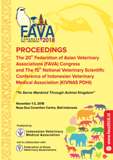MP-5 Antibiotic Resistance of Klebsiella Species Isolated from Broiler Chickens in Sukabumi and Bogor Areas
Abstract
Animal protein needs in Indonesia increase every year. One source of animal protein that is affordable for all levels of society is poultry. Poultry mostly farmed in several parts of Indonesia. The region that has the largest poultry population in Indonesia is the province of West Java. The regions in West Java that contribute the highest poultry populations are Sukabumi and Bogor. The largest number of poultry populations is broiler chicken population, which is 108,304,978 tails.
Antibiotics often used in livestock and poultry as a prevention of disease transmission and as a growth promoter. Routine use of antibiotics in the livestock industry, especially chickens, has a negative impact. One of them is the emergence of antibiotic resistance. One of the bacteria that has experienced antibiotic resistance is the Klebsiella species.
Klebsiella bacteria are Gram-negative bacteria are normal flora in the oral cavity, skin and intestines, but can become pathogens in animals and humans under certain conditions. This bacterium is one of the causes of bacterial diseases that attack large livestock and poultry. Many reports say that Klebsiella species have experienced resistance to antibiotics. Klebsiella had experienced resistance to several antibiotics, namely ampicillin as much as 66.7%, Nalidixic Acid 61.8%, tetracycline 59.8% and trimethropin 50%. Klebsiella bacteria that are resistant to antibiotics are very dangerous for animal and human health. Diseases caused by Klebsiella bacteria that are resistant to antibiotics will be difficult to cure. Akova (2016) states that Gram-negative and Gram-positive bacteria that experience resistance will produce infections that are difficult to treat or cannot even be treated using antimicrobials.

